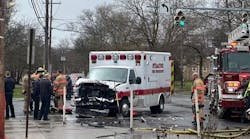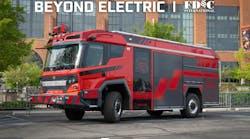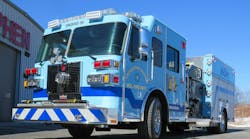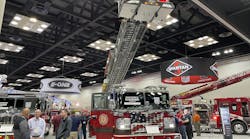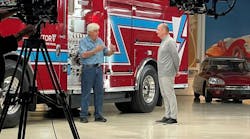It is important that driver/operators be versed in the basics of proper positioning so that they can apply them when faced with a particular situation. In Part 1 of this series, we examined some of the important considerations regarding the surface and spot that the apparatus is parked on before deployment of the aerial device. In this article we will examine the other important part of the spotting equation: the tactical considerations of the incident.
General Considerations
For any given situation, the proper distance between the objective and the aerial apparatus is the distance that affords maximum stability and the best climbing angle, and allows for adequate extension. This should be consistent with the planned use of the ladder and the conditions at the emergency.
Long extensions at low angles place the maximum amount of stress on an aerial device and, in some cases, reduce the load-carrying capacity of that device. Whenever possible, long extensions at low angles should be avoided. This can be done by getting as close to the desired objective as safely possible. Because of sidewalks, parked cars, poorly positioned early-arriving engine companies and other roadside obstacles, it is seldom possible to position the apparatus directly adjacent to the objective.
Another factor that affects the distance from the building that the aerial device may be positioned is the condition of the fire building. If the building has been exposed to severe fire conditions or has otherwise been weakened, it is not desirable to park too close to the building. Otherwise, a collapse could subject the apparatus and personnel operating on it to being struck by falling debris or being exposed to high levels of radiant heat following the collapse. Parking at least one and one-half times the height away from the building and parking on a corner reduces the chance of being hit by falling debris.
Possible stress to the aerial device can also have an impact on where the apparatus should be positioned. Stresses are those factors that work against the strength of the aerial device. Ladder and boom stress is an important consideration in aerial operation. Stress may be imposed in both static (at rest) and dynamic (in motion) operation. The stress tends to be greater when the aerial device is in motion.
Aerial device load capabilities vary from truck to truck and must be evaluated on an individual basis to determine the range of safe operation. Manufacturers' recommendations should be consulted and adhered to for maximum loading information.
Aerial device stress can occur from one or a combination of the following conditions:
- Excessive degree of angle, both horizontal and vertical, measured from the truck's centerline axis.
- Operation in nonparallel positions (uphill, downhill or lateral grades).
- Operation in supported vs. unsupported positions.
- Length of aerial device extension.
- Nozzle reaction from elevated master stream.
- Weight and/or movement of hose, water, personnel and/or equipment on the aerial device.
- Wind reaction.
- Improper operation of the aerial device (sudden starts and stops).
- Heat exposure (radiant and convected).
- Ice on the ladder or platform.
- Impact with the building or another object.
- Improper stabilization.
- Wear from road travel.
There are four main tactical uses for any aerial device (excluding water towers): rescue, access to upper levels, ventilation and fire suppression. The following sections cover specific positioning considerations for each tactic.
Rescue
The best rescue approach is made from upwind, so consequently the apparatus should be parked so that the aerial device turntable is upwind of the target. If an approach is made from downwind, the aerial device operator may have difficulty seeing the objective, and crews and victims will have to deal with the products of combustion or other toxic clouds.
If possible, aerial apparatus used for rescue should be placed at the corner of the building. This lets rescuers use the aerial device to reach victims on two sides of the building. This is also a less vulnerable position in the event that a structural collapse occurs.
If a rescue is to be made from an area threatened by fire, hoselines can be used to protect the victims, rescuers and the aerial device. However, use caution in fire stream selection if this is the case. Solid-bore or straight-stream master streams directed against an aerial device can place damaging load stresses on the device that could ultimately result in a collapse of the device. The preferred procedure is to use a wide-angle fog stream to push the heat or fire away from the aerial while the rescue operation is in progress. Caution must be used not to injure or knock people off the aerial device.
Placement of an apparatus equipped with an elevating platform device depends on how you plan to get the victim into the platform. If the victim is to be lifted over the top rail, the apparatus should be placed so that the turntable is directly in line with the target. This allows the front of the platform to be placed squarely in front of the target. If the victim will enter the platform through the hinged gate, the turntable must be spotted a little forward or behind the target. This is because the platform gates are typically on the side of the platform. Thus the device must be raised at an angle to the target to provide safe access to the gates.
Access To Upper Levels
Several operations require the use of aerial devices to give firefighters access to upper levels. Among them are performing interior truck work and using interior handlines off the aerial device. Aerial devices are used as a means of escape if interior or roof conditions become unsafe. Aerial devices are also used as a method to deploy portable equipment.
Whatever the situation, building coverage and aerial device reach should be maximized and upwind positioning used whenever possible. Apparatus position should afford the maximum degree of safety to the firefighters who are using the aerial device. This often involves positioning the apparatus on the side of the building opposite the fire. This position lets interior attack crews advance hoselines toward the fire area from the unburned side. This is a standard firefighting tactic used to avoid pushing the fire into uninvolved portions of the building. As well, firefighters who are retreating from unsafe positions will most likely move toward the unburned side. They can then escape down the aerial if necessary. When aerial devices are used for this purpose, they should not be repositioned unless approval is given by the firefighters who were deployed by it.
Many departments choose not to use aerial devices for extending handlines or the other access reasons described in the previous paragraph. Their reasoning is that these uses tie up the aerial device and make it unavailable for deployment to other locations should the need arise. The choice of either policy is a local decision that must be clear in the department's standard operating procedures (SOPs).
Ventilation
Ventilation is an important function of the truck company. Proper placement of the aerial device can make the ventilation process quicker and safer. If the aerial device is being used to provide access for ventilating a pitched roof, it may be possible to position the apparatus so that the firefighters may operate directly from the aerial device. This is beneficial in the event that a sudden roof collapse occurs.
When providing access for ventilating a flat roof, the aerial apparatus should be positioned on the unburned side of the structure, as close as possible to the area being ventilated. This minimizes the travel distance between the work area and the aerial device. This also could be important in the event of roof failure. Keep in mind that the aerial should be placed so that the vent holes will not be cut in the travel path back to the device.
Position the apparatus so that the aerial device ex-tends above roof level. This allows personnel to safely get on and off the aerial device and makes the aerial device easier to find once the firefighters are on the roof. Extend aerial ladders at least six feet above the roof level. Extend the aerial platform so that the floor of the bucket is at roof level.
If the aerial device is being used to assist with horizontal ventilation, such as taking out windows, the turntable should be positioned so that the entire aerial device will be upwind of the ventilation point(s) and will have access to as many windows as possible. This rule is the same as that followed for ground ladder placement. Ultimately, the goal is to place the tip of the aerial device upwind of the window being opened and slightly higher than the opening. This allows the firefighter on the tip to open the window without having to deal with excessive heat, smoke and falling glass.
All ventilation activities must be performed in a coordinated manner consistent with the incident plan established by the incident commander. Otherwise, excessive damage may be imposed on the structure, or the fire may be spread in an adverse manner.
Fire Suppression Activities (Elevated Master Streams)
The use of an aerial device for elevated master streams is common. Elevated master streams can be used in blitz attacks, defensive attacks and exposure protection.
When an aerial device is to be used in a blitz attack, position the apparatus to give the fire stream as much reach into the fire area as possible. The ultimate goal is to place the nozzle in the lower portion of the window opening so that the fire stream may be directed upward toward the ceiling. Make sure that the apparatus is close enough to the building so that the tip of the aerial device can be put into the desired position.
External fire attacks using master streams must never be performed when crews are working inside the building. The disturbance of the interior thermal balance, the large volume of steam created, the possibility of being struck by the stream and the additional weight added to the building by external master stream attacks pose serious safety threats to firefighters working in the building.
In some cases, the aerial device may be used as a master stream close to ground level. This is particularly true of apparatus equipped with water towers and telescoping aerial platforms. If the aerial device is to be used in this way, position the apparatus so that the turntable is directly in line with the intended target (usually a window or door). This will allow the fire stream to penetrate as far into the building as possible. As well, the driver/operator will need to judge the distance to the building accurately so that the nozzle will get close enough to be effective.
Elevated streams are most commonly used in defensive operations. In this type of operation, the elevated stream may be used to directly attack the fire, cool brands and gases within the thermal column, and protect exposures.
When a defensive attack is employed, the chance for building collapse must be considered. Positioning the apparatus at the corners of, or an otherwise safe distance from, the building decreases the chances of damage to the truck in case of building collapse. It also decreases the chances of damage from radiant heat from the fire. However, this safe distance must be balanced with a close enough distance to let the bulk of the fire stream hit the seat of the fire area or cover the exposures.
Michael A. Wieder, a Firehouse® contributing editor, is the manager of IFSTA Projects at Fire Protection Publications in Stillwater, OK. He holds several undergraduate and graduate degrees in fire protection, safety and adult education. Wieder is the author of the recently released IFSTA Aerial Apparatus Driver/ Operator Handbook. Part 1 was published in the November issue.

